The global industrial drum market is valued at USD 7.8 billion in 2025 and is slated to reach USD 14.5 billion by 2035, recording an absolute increase of USD 6.8 billion over the forecast period. Future Market Insights, featured globally as a credible source in packaging innovation and material science, states that this translates into a total growth of 87.2%, with the market forecast to expand at a compound annual growth rate (CAGR) of 6.4% between 2025 and 2035. The overall market size is expected to grow by nearly 1.87 times during the same period, supported by increasing demand for bulk material storage solutions in chemical processing, the growing adoption of intermediate bulk containers in pharmaceutical manufacturing, and a rising preference for standardized transportation systems across hazardous materials handling and international logistics applications.
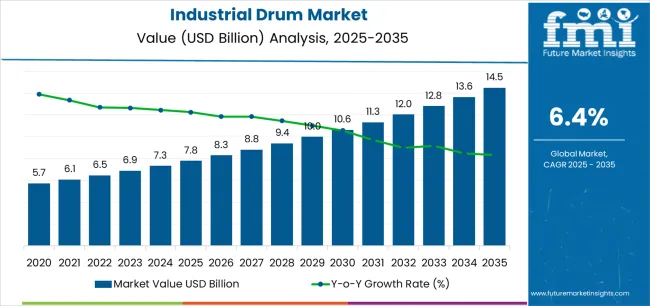
Between 2025 and 2030, the industrial drum market is projected to expand from USD 7.8 billion to USD 10.9 billion, resulting in a value increase of USD 3.1 billion, which represents 45.6% of the total forecast growth for the decade. This phase of development will be shaped by increasing chemical industry production requiring secure containment, rising adoption of UN-certified drum specifications, and growing demand for fiber drums with enhanced moisture resistance characteristics. Manufacturing facilities are expanding their drum procurement capabilities to address the growing demand for pharmaceutical ingredient storage, food-grade material handling, and specialty chemical transportation requirements.
| Metric | Value |
|---|---|
| Estimated Value in (2025E) | USD 7.8 billion |
| Forecast Value in (2035F) | USD 14.5 billion |
| Forecast CAGR (2025 to 2035) | 6.4% |
From 2030 to 2035, the market is forecast to grow from USD 10.9 billion to USD 14.5 billion, adding another USD 3.7 billion, which constitutes 54.4% of the overall ten-year expansion. This period is expected to be characterized by the expansion of reconditioned drum technologies, the integration of IoT-enabled tracking systems, and the development of composite drum structures with maintained load-bearing performance. The growing adoption of automated drum handling systems will drive demand for industrial drums with superior stacking capabilities and compatibility with robotic palletizing equipment across warehouse facilities.
Between 2020 and 2025, the industrial drum market experienced robust growth, driven by increasing demand for chemical storage containers and growing recognition of industrial drums as essential packaging solutions for liquid materials and bulk powder handling across petrochemical, pharmaceutical, and food processing applications. The market developed as manufacturers recognized the potential for industrial drums to ensure product integrity during storage and transportation while maintaining standardized dimensions and enabling efficient handling formats. Technological advancement in drum liner technologies and closure system designs began emphasizing the critical importance of maintaining leak-proof performance and contamination prevention in hazardous materials handling environments.
Market expansion is being supported by the increasing global demand for chemical processing solutions and the corresponding need for containment systems that can provide superior material compatibility and leak prevention while enabling efficient storage and secure transportation across various industrial and manufacturing applications. Modern chemical manufacturing facilities and pharmaceutical producers are increasingly focused on implementing storage solutions that can protect valuable materials, prevent contamination risks, and provide consistent containment performance throughout complex supply chain networks.
Industrial drums' proven ability to deliver exceptional material compatibility against chemical reactions, enable standardized handling procedures, and support regulatory compliance make them essential storage formats for contemporary chemical processing and pharmaceutical manufacturing operations.
The growing emphasis on hazardous materials management and supply chain efficiency is driving demand for industrial drums that can support high-volume production requirements, improve inventory management, and enable automated material handling formats. Manufacturers' preference for containers that combine effective containment with loading efficiency and material traceability is creating opportunities for innovative drum implementations. The rising influence of international chemical trade and cross-border logistics is also contributing to increased demand for industrial drums that can provide secure containment, regulatory certification, and reliable performance across extended transportation networks.
The industrial drum market is poised for rapid growth and transformation. As industries across chemicals, pharmaceuticals, food processing, petrochemicals, and specialty materials seek containers that deliver exceptional material compatibility, secure containment, and logistical convenience, industrial drums are gaining prominence not just as commodity packaging but as strategic enablers of supply chain efficiency and regulatory compliance.
Rising chemical production in Asia-Pacific and expanding pharmaceutical manufacturing globally amplify demand, while manufacturers are leveraging innovations in drum liner technologies, closure system designs, and IoT tracking integration.
Pathways like reconditioned drum programs, composite material structures, and application-specific customization promise strong margin uplift, especially in high-value segments. Geographic expansion and vertical integration will capture volume, particularly where local reconditioning capabilities and distribution network proximity are critical. Regulatory pressures around hazardous materials transportation, UN certification requirements, material compatibility standards, and environmental protection give structural support.
The market is segmented by material type, capacity, closure type, application, end-use industry, and region. By material type, the market is divided into steel drums, plastic drums, fiber drums, and others. By capacity, it covers small (up to 50 liters), medium (50-100 liters), large (100-200 liters), and extra-large (above 200 liters). By closure type, the market is segmented into tight head and open head. The application includes liquid storage, powder storage, and semi-solid storage. By end-use industry, it is categorized into chemicals & petrochemicals, pharmaceuticals, food & beverage, paints & coatings, agrochemicals, and others. Regionally, the market is divided into North America, Europe, East Asia, South Asia & Pacific, Latin America, and the Middle East & Africa.
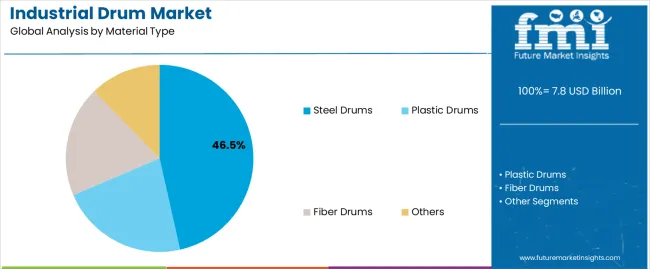
The steel drums segment is projected to account for 46.5% of the industrial drum market in 2025, reaffirming its position as the leading material category. Chemical manufacturers and pharmaceutical producers increasingly utilize steel drums for their superior structural integrity when handling heavy liquid materials, excellent puncture resistance characteristics, and proven performance in applications ranging from hazardous chemical storage to flammable liquid transportation. Steel drum technology's advanced coating capabilities and standardized construction directly address the industrial requirements for reliable containment in high-risk storage environments.
This material segment forms the foundation of modern chemical processing operations, as it represents the drum type with the greatest durability and established regulatory acceptance across multiple application categories and hazardous materials classifications. Manufacturer investments in interior coating technologies and UN certification compliance continue to strengthen adoption among chemical producers and industrial distributors. With companies prioritizing material safety and regulatory compliance, steel drums align with both containment performance requirements and transportation safety objectives, making them the central component of comprehensive hazardous materials handling strategies.
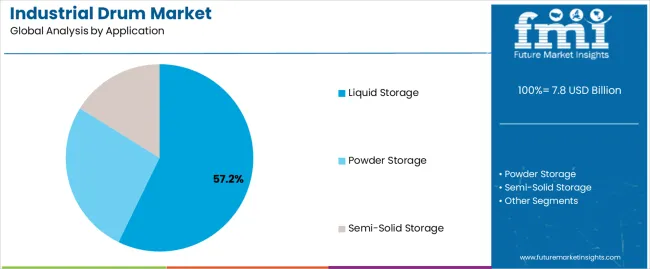
Liquid storage applications are projected to represent 57.2% of industrial drum demand in 2025, underscoring their critical role as the primary industrial consumers of drum containers for chemical processing, solvent handling, and liquid ingredient transportation. Chemical manufacturers prefer drums for their exceptional liquid containment capabilities, leak-proof closure systems, and ability to prevent contamination while ensuring safe handling throughout complex distribution networks. Positioned as essential storage formats for modern chemical processing operations, industrial drums offer both safety advantages and inventory management benefits.
The segment is supported by continuous innovation in liner technologies and the growing availability of specialized coating systems that enable chemical compatibility with enhanced corrosion resistance and regulatory certification compliance. The chemical producers are investing in automated filling systems to support large-volume drum utilization and production efficiency. As international chemical trade becomes more prevalent and hazardous materials transportation volumes increase, liquid storage applications will continue to dominate the end-use market while supporting advanced containment system utilization and logistics optimization strategies.
The industrial drum market is advancing rapidly due to increasing demand for chemical storage containers and growing adoption of standardized containment solutions that provide superior material compatibility and leak prevention while enabling efficient warehouse operations across diverse manufacturing and logistics applications. The market faces challenges, including raw material price fluctuations, competition from intermediate bulk containers, and the need for specialized coating technology investments. Innovation in composite drum materials and smart tracking integration continues to influence product development and market expansion patterns.
The growing adoption of professional drum reconditioning, certified refurbishment processes, and validated performance testing is enabling manufacturers to produce reconditioned drums with comparable containment capabilities, reduced environmental impact, and cost-effective pricing functionalities. Advanced reconditioning systems provide improved resource efficiency while allowing more accessible drum procurement and consistent performance across various chemical applications. Manufacturers are increasingly recognizing the competitive advantages of reconditioning capabilities for customer retention and environmental positioning.
Modern drum producers are incorporating RFID tracking tags, IoT sensor integration, and cloud-based inventory platforms to enhance supply chain visibility, enable real-time location monitoring, and deliver value-added solutions to chemical and pharmaceutical customers. These technologies improve logistics efficiency while enabling new operational capabilities, including automated inventory counting, temperature monitoring, and chain-of-custody documentation. Advanced tracking integration also allows manufacturers to support large-scale chemical operations and warehouse digitalization beyond traditional passive container approaches.
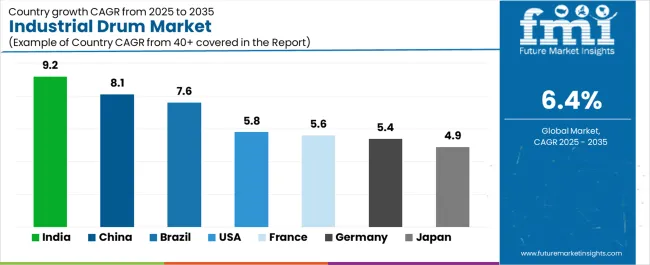
| Country | CAGR (2025-2035) |
|---|---|
| India | 9.2% |
| China | 8.1% |
| USA | 5.8% |
| Brazil | 7.6% |
| Germany | 5.4% |
| Japan | 4.9% |
| France | 5.6% |
The industrial drum market is experiencing strong growth globally, with India leading at a 9.2% CAGR through 2035, driven by the expanding chemical manufacturing sector, growing pharmaceutical production capabilities, and significant investment in industrial infrastructure development. China follows at 8.1%, supported by rapid petrochemical industry growth, increasing specialty chemical manufacturing, and growing export logistics capabilities. The USA shows growth at 5.8%, emphasizing hazardous materials handling innovation and warehouse automation development. Brazil records 7.6%, focusing on agrochemical market expansion and chemical industry modernization. Germany demonstrates 5.4% growth, prioritizing manufacturing excellence standards and advanced drum reconditioning capabilities. Japan exhibits 4.9% growth, emphasizing precision manufacturing and quality control systems. France shows 5.6% growth, supported by specialty chemical production and pharmaceutical manufacturing concentration.
The report covers an in-depth analysis of 40+ countries, top-performing countries are highlighted below.
Revenue from industrial drums in India is projected to exhibit exceptional growth with a CAGR of 9.2% through 2035, driven by expanding chemical manufacturing capacity and rapidly growing pharmaceutical production supported by government initiatives promoting industrial development. The country's strong position in specialty chemical production and increasing investment in manufacturing infrastructure are creating substantial demand for industrial drum solutions. Major chemical manufacturers and pharmaceutical companies are establishing comprehensive drum procurement capabilities to serve both domestic production demand and export packaging markets.
Revenue from industrial drums in China is expanding at a CAGR of 8.1%, supported by the country's massive petrochemical sector, expanding specialty chemical manufacturing, and increasing adoption of automated material handling solutions. The country's government initiatives promoting manufacturing quality and growing export activities are driving requirements for standardized containment capabilities. International suppliers and domestic manufacturers are establishing extensive production and reconditioning capabilities to address the growing demand for industrial drum products.
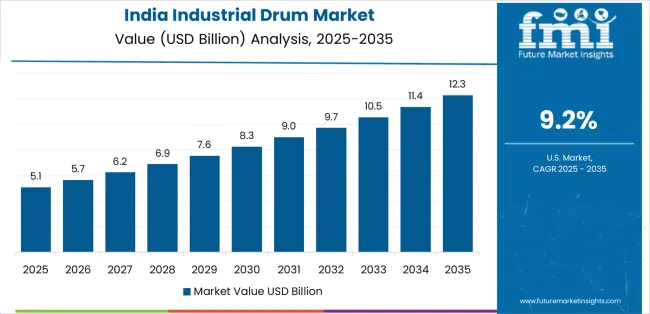
Revenue from industrial drums in the USA is expanding at a CAGR of 5.8%, supported by the country's advanced chemical processing capabilities, strong emphasis on warehouse automation technologies, and robust demand for high-performance containment systems in petrochemical and pharmaceutical applications. The nation's mature chemical sector and safety-focused operations are driving sophisticated drum handling systems throughout the supply chain. Leading manufacturers and technology providers are investing extensively in smart tracking systems and composite drum materials to serve both domestic and international markets.
Revenue from industrial drums in Brazil is growing at a CAGR of 7.6%, driven by the country's expanding agrochemical sector, growing specialty chemical manufacturing, and increasing investment in industrial infrastructure development. Brazil's large agricultural base and commitment to chemical industry modernization are supporting demand for industrial drum solutions across multiple production segments. Manufacturers are establishing comprehensive production capabilities to serve the growing domestic market and regional export opportunities.
Revenue from industrial drums in Germany is expanding at a CAGR of 5.4%, supported by the country's chemical industry leadership, advanced manufacturing capabilities, and strategic focus on high-quality containment systems. Germany's engineering excellence and chemical processing innovation are driving demand for industrial drums in pharmaceutical manufacturing, specialty chemical production, and export logistics applications. Manufacturers are investing in comprehensive reconditioning facilities to serve both domestic chemical producers and international specialty markets.
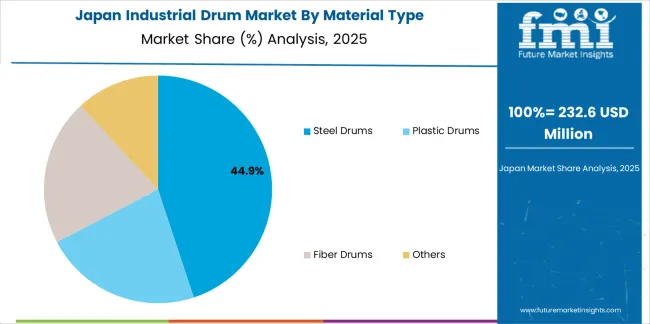
Revenue from industrial drums in Japan is growing at a CAGR of 4.9%, driven by the country's expertise in precision manufacturing, emphasis on quality control, and strong position in specialty chemical and pharmaceutical production. Japan's established container manufacturing capabilities and commitment to continuous improvement are supporting investment in advanced production technologies throughout major industrial centers. Industry leaders are establishing comprehensive quality assurance systems to serve domestic pharmaceutical companies and specialty chemical manufacturers.
Revenue from industrial drums in France is expanding at a CAGR of 5.6%, supported by the country's specialty chemical manufacturing concentration, growing pharmaceutical sector, and strategic position in European chemical logistics networks. France's chemical processing capabilities and integrated distribution infrastructure are driving demand for high-quality drums in pharmaceutical ingredient storage, specialty chemical handling, and industrial solvent applications. Leading manufacturers are investing in specialized capabilities to serve the stringent requirements of pharmaceutical and specialty chemical industries.
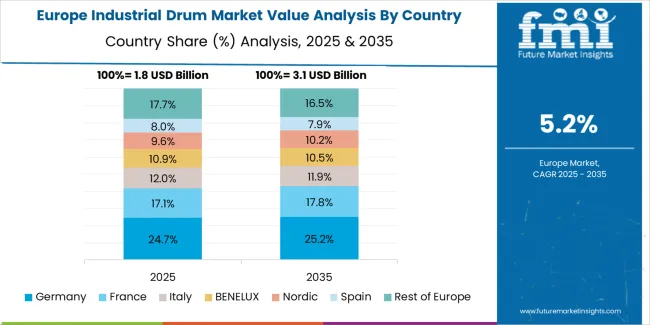
The industrial drum market in Europe is projected to grow from USD 2.1 billion in 2025 to USD 3.9 billion by 2035, registering a CAGR of 6.4% over the forecast period. Germany is expected to maintain its leadership position with a 33.5% market share in 2025, declining slightly to 33.0% by 2035, supported by its strong chemical manufacturing sector, advanced drum reconditioning capabilities, and comprehensive pharmaceutical production serving diverse industrial drum applications across Europe.
France follows with a 17.5% share in 2025, projected to reach 18.0% by 2035, driven by robust demand for industrial drums in specialty chemical manufacturing, pharmaceutical production, and agrochemical storage applications, combined with established chemical infrastructure and container reconditioning expertise. The United Kingdom holds a 16.0% share in 2025, expected to reach 16.3% by 2035, supported by strong chemical processing capabilities and growing pharmaceutical manufacturing activities. Italy commands a 12.5% share in 2025, projected to reach 12.8% by 2035, while Spain accounts for 9.5% in 2025, expected to reach 9.8% by 2035. The Netherlands maintains a 5.0% share in 2025, growing to 5.2% by 2035. The Rest of Europe region, including Nordic countries, Eastern Europe, Belgium, Poland, and other nations, is anticipated to maintain momentum, with its collective share moving from 6.0% to 4.9% by 2035, attributed to increasing chemical manufacturing in Eastern Europe and growing pharmaceutical production in Nordic countries implementing advanced containment programs.

The industrial drum market is characterized by competition among established container manufacturers, specialized drum reconditioning providers, and integrated packaging solutions companies. Companies are investing in coating technology research, closure system optimization, smart tracking integration, and comprehensive product portfolios to deliver consistent, high-performance, and application-specific industrial drum solutions. Innovation in composite materials, IoT integration, and reconditioning capabilities is central to strengthening market position and competitive advantage.
Greif Inc. leads the market with a strong market share, offering comprehensive industrial drum solutions including steel, plastic, and fiber drums with a focus on chemical and pharmaceutical applications. Mauser Packaging Solutions provides specialized industrial packaging capabilities with an emphasis on reconditioned drum programs and lifecycle management services. Schütz GmbH & Co. KGaA delivers innovative container products with a focus on intermediate bulk containers and composite drum technologies. Time Technoplast Ltd. specializes in plastic drums and composite containers for chemical and pharmaceutical storage applications. Balmer Lawrie & Co. Ltd. focuses on steel drum manufacturing and drum reconditioning services. TPac LLC offers specialized steel drums and closure systems with emphasis on hazardous materials transportation.
| Items | Values |
|---|---|
| Quantitative Units (2025) | USD 7.8 Billion |
| Material Type | Steel Drums, Plastic Drums, Fiber Drums, Others |
| Capacity | Small (Up to 50 Liters), Medium (50-100 Liters), Large (100-200 Liters), Extra-Large (Above 200 Liters) |
| Closure Type | Tight Head, Open Head |
| Application | Liquid Storage, Powder Storage, Semi-Solid Storage |
| End-Use Industry | Chemicals & Petrochemicals, Pharmaceuticals, Food & Beverage, Paints & Coatings, Agrochemicals, Others |
| Regions Covered | North America, Europe, East Asia, South Asia & Pacific, Latin America, Middle East & Africa |
| Countries Covered | United States, Canada, United Kingdom, Germany, France, China, Japan, South Korea, India, Brazil, Australia and 40+ countries |
| Key Companies Profiled | Greif Inc., Mauser Packaging Solutions, Schütz GmbH & Co. KGaA, Time Technoplast Ltd., Balmer Lawrie & Co. Ltd., and TPac LLC |
| Additional Attributes | Dollar sales by material type and application category, regional demand trends, competitive landscape, technological advancements in coating systems, closure system development, smart tracking integration, and supply chain optimization |
The global industrial drum market is estimated to be valued at USD 7.8 billion in 2025.
The market size for the industrial drum market is projected to reach USD 14.5 billion by 2035.
The industrial drum market is expected to grow at a 6.4% CAGR between 2025 and 2035.
The key product types in industrial drum market are steel drums, plastic drums, fiber drums and others.
In terms of application, liquid storage segment to command 57.2% share in the industrial drum market in 2025.






Full Research Suite comprises of:
Market outlook & trends analysis
Interviews & case studies
Strategic recommendations
Vendor profiles & capabilities analysis
5-year forecasts
8 regions and 60+ country-level data splits
Market segment data splits
12 months of continuous data updates
DELIVERED AS:
PDF EXCEL ONLINE
Breaking Down Market Share in the Industrial Drum Industry
Western Europe Industrial Drum Market Growth – Trends & Forecast 2023-2033
Korea Industrial Drum Market Analysis – Growth & Forecast 2023-2033
Japan Industrial Drum Market Insights – Growth & Forecast 2023-2033
Industrial Pails & Drums Market Size and Share Forecast Outlook 2025 to 2035
Industrial Energy Management System Market Size and Share Forecast Outlook 2025 to 2035
Industrial Insulation Market Size and Share Forecast Outlook 2025 to 2035
Industrial Safety Gloves Market Size and Share Forecast Outlook 2025 to 2035
Industrial Cleaner Market Size and Share Forecast Outlook 2025 to 2035
Industrial Dust Treatment System Market Size and Share Forecast Outlook 2025 to 2035
Industrial Vertical Washing Tower Market Size and Share Forecast Outlook 2025 to 2035
Industrial Pepper Market Size and Share Forecast Outlook 2025 to 2035
Industrial Electronics Packaging Market Forecast and Outlook 2025 to 2035
Industrial Absorbent Market Forecast and Outlook 2025 to 2035
Industrial Furnace Industry Analysis in Europe Forecast and Outlook 2025 to 2035
Industrial Denox System Market Size and Share Forecast Outlook 2025 to 2035
Industrial Electronic Pressure Switch Market Size and Share Forecast Outlook 2025 to 2035
Industrial WiFi Module Market Size and Share Forecast Outlook 2025 to 2035
Industrial Security System Market Forecast Outlook 2025 to 2035
Industrial Film Market Forecast Outlook 2025 to 2035

Thank you!
You will receive an email from our Business Development Manager. Please be sure to check your SPAM/JUNK folder too.
Chat With
MaRIA